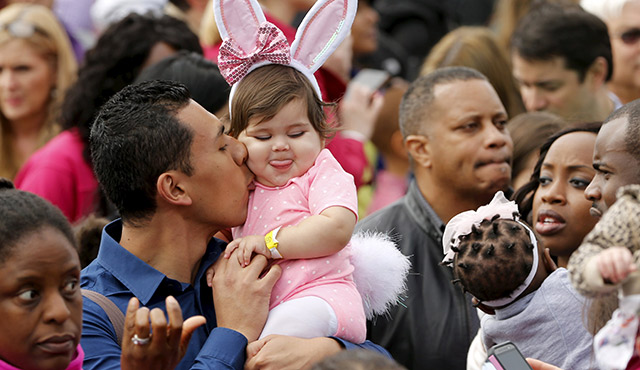To young children, Easter means chocolate bunnies, egg hunts and colorful baskets filled with goodies. Parents and teachers, however, want to teach children to understand Easter as the cornerstone of the Catholic faith. Are the holiday’s secular traditions and faith-based meaning mutually exclusive or can children hunt for eggs and still grasp the concept of the Resurrection?
“Children love stories and this is the greatest story ever told,” says Katie Dawson, director of Parish Faith Formation of the Diocese of Orange. “It’s simply the story of God the father who loves us very much. The human race made bad decisions and damaged the relationship with God, so Jesus came to fix the problem with that relationship. Even though Jesus died, love made him rise again.”
Dawson says that with small children, parents and teachers should focus not on the suffering and death of the Savior but on the love that made Jesus rise on Easter morning.
“One concern parents have is that part of the story of Jesus’s death and resurrection is really tragic. Just like a lot of other things that are hard to talk about, it’s best to give them just the information they ask for,” she says. “They don’t need lots of detail or theology – just to know that there was something wrong and Jesus came and fixed it.”
Chocolate and marshmallow eggs and bunnies are traditional ways of celebrating Easter as a secular national holiday. Still, each part of the celebration can be correlated to the wonder of Easter in the religious sense.
“Eggs are a symbol of Jesus’s tomb and inside each one is a message of salvation,” explains Debbie Vallas, principal of Christ Cathedral Academy. “When we dress up for Easter, we send a symbolic message that we are glorified and stand in the shadow of our Lord. We show our respect for what He did for us; we have been cleansed and given a new beginning.”
The Lenten preparations of fasting, prayer, almsgiving and Stations of the Cross prepare children to go through Calvary with Jesus to reach the wondrous point of the Resurrection, Vallas says.
“It can’t be Easter without Lent,” she notes. “We are a people of hope and that’s what Lent does for us. We become empty so that the Lord can fill us up. The journey through Lent is all about Christ rising.”
At Christ Cathedral Academy, she explains, children are encouraged during Lent to not only give up pleasurable things and pursuits but also to acknowledge how God works in their lives. “We make small sacrifices to the Lord by doing something out of the ordinary to give to others,” she says. “We become a friend to someone who doesn’t have friends, or give money or volunteer in a drive for the homeless. We give of ourselves.”
Catholic schools and churches drape crosses with purple, the color of Lent, and decorate bare winter trees with children’s intentions as ways to reflect on the Lenten journey.
“Primary kids ask more about why Jesus died for us,” Vallas says. “They want to know what Easter means and why we celebrate it. Older children have more forward-thinking questions, such as the message of Easter. They approach Easter with a higher level of thinking and wonder why Jesus had to be crucified.”
At Easter, Jesus conquers death and makes believers a people of hope. “We call that the source and summit of our faith,” Vallas notes. “When Jesus conquers death it shows us that we too can rise again. It is what we’re doing here that gets us to heaven to share eternity with Him.”
A glorious day in spring, she adds, Easter transcends all faiths and offers a message of hope to everyone.

